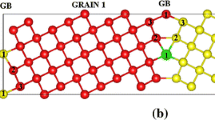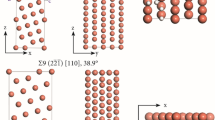Abstract
Geometrical modeling of the B2 structure indicates that the tetrahedral interstitial site is always the largest both before and after an α/2〈111〉 translation on {110}, such as occurs during the slip of a partial dislocation in some B2 compounds. The tetrahedral site within the APB which trails a gliding a/2〈111〉 dislocation is larger than in the unslipped lattice, suggesting that interstitial atoms will segregate there. Also, some interstitial sites in a B2 lattice are larger than those in a bcc lattice of the same lattice parameter, suggesting that interstitials may have greater solubility in B2 compounds.
Similar content being viewed by others
Change history
01 October 1993
An Erratum to this paper has been published: https://doi.org/10.1557/JMR.1993.2741
References
I. Baker and P.R. Munroe, in High Temperature Aluminides and Intermetallics, edited by S.H. Whang, C.T. Liu, D.P. Pope, and J. O. Stiegler (TMS, Warrendale, PA, 1990), p. 425.
Author information
Authors and Affiliations
Rights and permissions
About this article
Cite this article
Baker, I. Hard sphere modeling of the effect of slip on interstitial sites in the B2 structure. Journal of Materials Research 8, 1203–1205 (1993). https://doi.org/10.1557/JMR.1993.1203
Received:
Accepted:
Published:
Issue Date:
DOI: https://doi.org/10.1557/JMR.1993.1203




